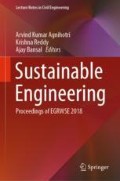Abstract
Aeration is a process, which helps in the enhancement of concentration of dissolved oxygen in water. This concentration of dissolved oxygen (DO) is required for sustaining aquatic life and is also considered as an indicator of the quality of water. The DO can be enhanced by using either mechanical aerator or by hydraulic structures. Hydraulic structures accelerate the water–air–mass transfer by entraining a large amount of air in the form of bubble, thus increasing surface contact area for full oxygen transfer. Commonly hydraulic structures used for aeration are weirs, spillways, cascades, water jets and close conduit flow arrangements, etc. When the performance of weirs is compared with other aerating agents like hydraulic jump, labyrinth weirs, chute etc., it was found that weirs give maximum oxygen transfer efficiency. The researchers have used rectangular-, triangular-, trapezoidal- and semicircular-shaped weirs for DO studies in the past. The present paper looks into the literature review of weirs having free surface when employed for aeration purpose for wastewater treatment. It was found that the triangular-shaped weir has created maximum oxygen transfer efficiency out of all other shapes of weir. It is expected that findings of this study will help in the selection of particular weir configuration and shape of weir for creating maximum oxygen transfer efficiency in the rivers and streams for the purpose of treatment of water.
Access this chapter
Tax calculation will be finalised at checkout
Purchases are for personal use only
References
Bagatur T (2009) Evaluation of pre-aeration with V- notch weir and cascades structures in clarifiers. J Environ Eng 135(3):176–184
Baylar A, Bağatur T (2000) Study of aeration efficiency at weirs. Turk J Eng Environ Sci 24(4):255–264
Baylar A, Bagatur T, Tuna A (2001) Aeration performance of triangular-notch weirs. Water Environ J 15(3):203–206
Baylar A, Emiroglu ME (2002) The effect of sharp-crested weir shape on air entrainment. Can J Civ Eng 29(3):375–383
Baylar A, Hanbay D, Ozpolat E (2008) An expert system for predicting aeration performance of weirs by using ANFIS. Expert Syst Appl 35(3):1214–1222
Baylar A, Unsal M, Ozkan F (2010) Hydraulic structures in water aeration processes. Water Air Soil Pollut 210(1–4):87–100
Chanson H (1995) Hydraulic design of stepped cascades, channels, weirs and spillways. Pergamon, Oxford, U.K
Eckenfelder WW Jr, Ford DL (1970) Water pollution control. Pemberton Press, Austin and New York
Emiroglu ME, Baylar A (2003a) The effect of broad-crested weir shape on air entrainment. J Hydraul Res 41(6):649–655
Emiroglu ME, Baylar A (2003b) Experimental study of the influence of different weir types on the rate of air entrainment. Water Qual Res J Can 38(4):769–783
Gameson ALH (1957) Weirs and aeration of rivers. J Inst Water Eng 11(5):477–490
Goel A (2015) Modeling aeration of sharp crested weirs by using support vector machines. WASET Int J Mech Aerosp Ind Mech Manuf Eng 7(12):2620–2625
Gulliver JS, Rindels AJ (1993) Measurement of air-water oxygen transfer at hydraulic structures. J Hydraulic Eng 119(3):327–349
Gulliver JS, Wilhelms SC, Parkhill KL (1998) Predictive capabilities in oxygen transfer at hydraulic structures. J Hydraulic Eng 124(7):664–671
Heza YBM, El-din M, Donia NS, Refaat AM (2008) Water quality improvement of drains polluted by wastewater using conventional weir. In: Welfth international water technology conference, IWTC12
Kim J, Walters RW (2001) Oxygen transfer at low drop weirs. J Environ Eng 127(7):604–610
Lempérière F, Ouamane A (2003) The Piano Keys weir: a new cost-effective solution for spillways. Int J Hydropower Dams 10(5):144–149
Macaitis B, Reclamation MW (1990) Side stream elevated pool aeration station design. MOO, p 199
Markofsky M, Kobus H (1978) Unified presentation of weir-aeration data. J Hydraulics Div 104:562–568
Nakasone H (1987) Study of aeration at weirs and cascades. J Environ Eng 113(1):64–81
Poommai S, Chunkao K, Bualerd S (2012) Variation of oxygen transfer along the rectangular weir crest distance of wastewater treatment pond. Procedia Environ Sci 13:498–512
Raikar RV, Kamatagi PB (2015) Use of hydraulic phenomena in enhancement of dissolved oxygen concentration. Int J Res Eng Technol 4(2)
Rindels AJ, Gulliver JS (1991) Oxygen transfer at spillways. Air-water mass transfer. In: Wilhelms S, Gulliver J (eds) Proceedings of 2nd international symposium, on gas transfer at water surfaces. ASCE, Reston, Va., pp 524–533
Tebbutt THY (1977) Reaeration performance of stepped cascades. J Inst of Water Engrs and Sci 31:285–297.
Van der karoon GT, Schram AH (1969) Weir aeration—part I: single free fall. Water 2(22):528–537
Watson CC, Walters RW, Hogan SA (1998) Aeration performance of low drop weirs. J Hydraulic Eng 124(1):65–71
Author information
Authors and Affiliations
Corresponding author
Editor information
Editors and Affiliations
Rights and permissions
Copyright information
© 2019 Springer Nature Singapore Pte Ltd.
About this paper
Cite this paper
Jaiswal, A., Goel, A. (2019). Aeration Through Weirs—A Critical Review. In: Agnihotri, A., Reddy, K., Bansal, A. (eds) Sustainable Engineering. Lecture Notes in Civil Engineering, vol 30. Springer, Singapore. https://doi.org/10.1007/978-981-13-6717-5_19
Download citation
DOI: https://doi.org/10.1007/978-981-13-6717-5_19
Published:
Publisher Name: Springer, Singapore
Print ISBN: 978-981-13-6716-8
Online ISBN: 978-981-13-6717-5
eBook Packages: EngineeringEngineering (R0)

